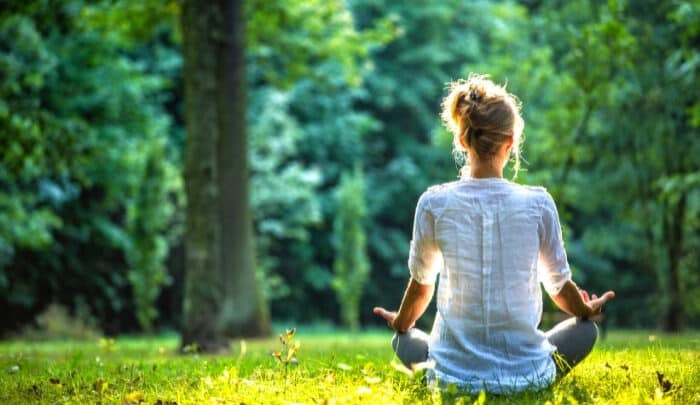Wondering how to meditate daily on your life to stay on track? After you get off the cushion, the most difficult and meaningful part of meditation may be when you get up.
It can make a big difference in your life if you apply the insights that you gain during meditation to your daily life.
You probably only meditate for a few minutes a day. This leaves you plenty of time to wander off the path, especially when you have deadlines at work or parenting at home.
Meditation can help you stay on track and integrate into your daily activities.
How To Meditate Daily On Your Life?
Here are some steps to take while you meditate:
1. Your intention
- Your intention will guide your actions. Setting goals will give you something to aim for and a roadmap to get there.
- Each meditation session begins with a reflection about your goals.
2. Focus on one thing
- Although meditation can improve any aspect of your daily life, it is not a good idea to try to do too many things at once.
- Prioritize your priorities and choose one project to start.
3. Make a resolution
- Decide what you will do differently today. If you put in enough effort, you can achieve something difficult but doable.
4. Make a timeline
- Although it may seem difficult to pay attention or stop swearing, you might be able to keep your resolution in place for an hour or two. These victories will add up.
Steps to Take Between Meditation Sessions
Slow down. Rushing is a distraction from mindfulness and awareness. To conserve and replenish energy, move slowly and take frequent breaks.
Be mindful when you eat. You can use meals as a trigger to remind you of anything. While you are enjoying your morning coffee, or eating lunch, think about your resolutions for the day.
Flexibility is key. You might see things differently than what you imagined while you meditated. You can adapt your resolution to any circumstances by looking for ways to do so.
Get motivated. Even if time is tight, a short meditation session can help you focus your thoughts. While you shower or drive to work, take a few deep breathes and chant a mantra.
Help others. Meditation can help you make new friends and strengthen your relationships. You will be happier if you show kindness and compassion to others.
Get a friend. If you feel accountable, you’re more likely than not to abandon any resolution. You can team up with a friend to give each other support and feedback.
Join a community. A whole community is more powerful than one meditation buddy. Look for places that offer meditation programs in your area. This could be yoga studios, community centres, or public libraries.
Be friends with yourself. Positive and gentle attitudes towards yourself will help you achieve more. You are worth everything you have. Instead of focusing on corrections, consider learning and growing as a gift for yourself.
Continue your studies. You can deepen your spiritual practice by learning more skills. Register for classes and browse online for books or videos.
Take care of your health. When your body is healthy, it’s easier for you to meditate. Regular exercise, healthy eating habits, and consistent sleeping patterns are key to meditation.
Meditation is not passive. Keep your eyes on the prize and apply what you have learned throughout your day to reap the benefits.
Daily Mediation for Beginners Video
From the video: Hello, I’m from beautiful British Columbia Canada, and today I’m going to share something with you. A few years ago I was going through a very difficult period In my life. In a moment of quiet desperation I decided to register for a six-week meditation course to help me cope with some of the anxiety and some of the emotions that I was experiencing.
After that I was eager to learn more, so I also registered for a 2-day, silent meditation retreat, and the things that I learned from the course and from the retreat have had such a profound impact on my life, and these are things I want to share with you today.
Now as a disclaimer I am not a meditation guru or expert and it’s also not in my Philosophy to do things in a way that feels strict or extreme so I’m just going to encourage you to do what feels good. I love the yogi who taught our course because he shared a very similar philosophy. He was always just encouraging us to do our best because essentially he didn’t want to scare us away from all the benefits of mindfulness and meditation.
Now also keep in mind that I am packing six weeks of information into three very short videos so I’m also going to encourage you to take the time after each video to really relish in the moment. I’ve also split it up into three videos to give you the Opportunity to practice each of the steps before you delve into learning some new ones.
Now in case you’re wondering the type of meditation that I learned is called what Asana meditation But possum adjust means insight or awareness or mindfulness. I’ll explain this more as we get into it. For now just enjoy it as a guided meditation that it is. I hope that you find this as useful as I did to learn now.
Let’s get started All right, so begin by finding a comfortable seat, some yogi’s say it matters how you cross your legs, but because we’re beginners, let’s just find any seat that feels comfortable and that puts you at ease. Place your hands either on your knees or in your lap whichever you prefer. I like to place one hand on top of the other palms facing upward in my lap with the thumbs touching, aligned with my nose.
We’re beginners so just do what feels good, if you have some kind of injury, do what you need to do to find support. This might mean propping up your back sitting in a chair supporting your knees with the pillow or keeping your legs straight. Ultimately, you know what feels best for your body, and if you have no injuries try to find a seated upright cross-legged position that feels most comfortable.
Once you find a comfortable seat you want to sit up straight but you also don’t want to forcefully elongate, that just doesn’t feel natural and you’ll get tired very quickly. You also want to make sure you’re not rounding through your neck so just press your chin back a little bit and now close your eyes and find some calm.
Once you’ve found a grounding position, aim to hold it through the meditation process. We don’t want to fidget or move, this can be the hardest part, but it gets easier with practice. Now if you’re new to meditation you may find that after a few minutes your leg might go numb, fall asleep, or start to tingle.
Ideally you want to ride this feeling out but if you really can’t and you feel you need to move we’ll cover the techniques on how to go about doing this in a mindful way in the third video of this series. For now just find a comfortable seat and hand positioning and hold it finally tune into the sensation. It all comes down to the breath.
Take a moment to tune into your natural breathing rhythm, you don’t need to take longer inhales or more forceful exhales. Just breathe as you normally would in and out through your nose into your belly. Now usually when we’re unconscious of the breath we breathe into the chest which is more often how long breathes.
When in a fight-or-flight response, breathing into the belly sends relaxation signals to the mind and mimics the breath when we are at rest, like when we’re sleeping. Have you ever watched a baby breathing the belly visibly rises and Falls. Breathing into the belly also helps to gently massage the internal organs and helps us become more aware of the sensations in the abdomen.
The beauty of an asana is that it allows for a moment-to-moment investigation of the mind-body process through a calm open and compassionate awareness. We learn to observe our experience from a place of spacious stillness which enables us to experience clarity and insight into the nature of who we are.
Now we become aware of the breath, when breathing in you feel that your abdomen is rising and when you exhale you feel your abdomen is dropping. Now all I want you to do is label this breathing so as you inhale you say silently to yourself in your mind Rising rising rising and as you exhale, you say silently to yourself in your mind falling falling falling.
Simply describing the rising and falling motion of the belly as it happens. So you continue rising rising rising and falling falling falling. Remember I said that it always comes down to the breath. So if your mind has wandered for a little bit, and you become aware of it simply bring that awareness back to the breath.
Continuously labeling it rising rising rising falling falling falling. All right, so I’m going to pause it there so we have a brief moment to recap in this video. We really just learned the basics which is essentially to find a comfortable seat and to remember to always return to the breath.
Labeling it as the abdomen rises and as it falls it’s all pretty simple, right? Another question is what do you do with certain sensations or emotions that arise or if certain thoughts enter into the mind while you’re meditating this is something we’re going to dive into in the next video.







